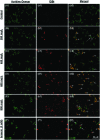Oxidative stress and mitochondrial impairment mediated apoptotic cell death induced by terpinolene in Schizosaccharomyces pombe
- PMID: 30310662
- PMCID: PMC6116180
- DOI: 10.1039/c8tx00100f
Oxidative stress and mitochondrial impairment mediated apoptotic cell death induced by terpinolene in Schizosaccharomyces pombe
Abstract
Terpinolene is one of the most abundant monoterpenes used as a food supplement or odorant in cosmetics and the pharmaceutical industry. In this study, we aimed to assess apoptotic, oxidative and cytotoxic effects of terpinolene. We used the fission yeast (Schizosaccharomyces pombe) as a promising uni-cellular model organism in molecular toxicology and cell death research, due to its resemblance to mammalian cells at the molecular level. After terpinolene exposure (200-800 mg L-1), the IC50 and LC50 were calculated as 349.17 mg L-1 and 593.87 mg L-1. Cells, stained with acridine orange/ethidium bromide and DAPI, showed apoptotic nuclear morphology, chromatin condensation and fragmentation. 2,7-Dichlorodihydrofluorescein diacetate (DCFDA) fluorescence gradually increased (1.5-2-fold increase) in correlation with increasing concentrations of terpinolene (200-800 mg L-1). Mitochondrial impairment at higher concentrations of terpinolene (400-800 mg L-1) was shown by Rhodamine 123 staining. Real-time PCR experiments showed significant increases (1.5-3-fold) in SOD1 and GPx1 levels (p < 0.05) as well as 2-2.5-fold increases (p < 0.05) in pro-apoptotic factors, Pca1 and Sprad9. The potential effects of terpinolene on programmed cell death and the underlying mechanisms were clarified in unicellular model fungi, Schizosaccharomyces pombe.
Figures








References
-
- Farooq A., Choudhary M. I., Rahman A. U., Tahara S., Başer K. H. C., Demirci F. Z. Naturforsch., C: J. Biosci. 2002;57:863–866. - PubMed
-
- Chueca B., Pagán R., García-Gonzalo D. Int. J. Food Microbiol. 2014;189:126–131. - PubMed
-
- Masten S. and Haneke K. E., Toxicological Summary For Turpentine [8006-64-2], https://ntp.niehs.nih.gov/ntp/htdocs/chem_background/exsumpdf/turpentine....
LinkOut - more resources
Full Text Sources
Miscellaneous

